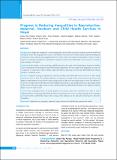Please use this identifier to cite or link to this item:
https://hdl.handle.net/20.500.14356/1074| Title: | Progress in Reducing Inequalities in Reproductive, Maternal, Newborn and Child Health Services in Nepal |
| Authors: | Pandey, Achyut Raj Ojha, Biwesh Shrestha, Niraj Maskey, Jasmine Sharma, Dikshya Godwin, Peter Chalise, Binaya Aryal, Krishna Kumar |
| Citation: | PandeyA. R., OjhaB., ShresthaN., MaskeyJ., SharmaD., GodwinP., ChaliseB., & AryalK. K. (2021). Progress in Reducing Inequalities in Reproductive, Maternal, Newborn and Child Health Services in Nepal. Journal of Nepal Health Research Council, 19(1), 140-147. https://doi.org/10.33314/jnhrc.v19i1.3375 |
| Issue Date: | 2021 |
| Publisher: | Nepal Health Research Council |
| Article Type: | Original Article |
| Keywords: | Health services inequality maternal Nepal newborn and child health reproductive health |
| Series/Report no.: | Jan-March, 2021;3375 |
| Abstract: | Abstract Background: Equity has emerged as a cross-cutting theme in the health sector, and countries across the world are striving to ensure that all people have access to the health services they need without undue financial hardship and educational, social, cultural and geographical barriers. In this context, this analysis has attempted to analyse Nepal’s progress in reducing inequalities in reproductive, maternal, newborn and child health services based on economic status and place of residence. Methods: In this analysis, we have used data available from the web version of the Health Equity Assessment Toolkit, a data visualisation tool developed by the World Health Organisation. We have analysed the inequalities in terms of a composite coverage index which combines eight reproductive, maternal, newborn and child health interventions along the continuum of care. Results: Composite coverage of reproductive, maternal, newborn and child health services was 43% in 2001 which increased to 65% in 2016. The absolute difference in composite coverage of the services between the lowest and highest wealth quintiles decreased from 28-percentage points in 2001 to 8-percentage points in 2016. The difference in service coverage between the urban and rural settings reduced from 21-percentage points to six percentage points in the period. Among the eight various services, births attended by skilled birth attendants is the indicator with the highest scope for improvement. Conclusions: Inequalities based on wealth quintiles and residence places have narrowed from 2001 to 2016. Additional efforts in expanding skilled birth attendants and antenatal care service coverage among the poorest quintile and rural residents could further improve the coverage of the indicators at the national level and narrow down the inequalities. Keywords: Health services; inequality; maternal; Nepal; newborn and child health; reproductive health |
| Description: | Original Article |
| URI: | http://103.69.126.140:8080/handle/20.500.14356/1074 |
| ISSN: | Print ISSN: 1727-5482; Online ISSN: 1999-6217 |
| Appears in Collections: | Vol. 19 No. 1 (2021): Vol. 19 No. 1 Issue 50 Jan-Mar 2021 |
Files in This Item:
| File | Description | Size | Format | |
|---|---|---|---|---|
| 3375-Manuscript-21566-2-10-20210425.pdf | Fulltext Download | 258.61 kB | Adobe PDF |  View/Open |
Items in DSpace are protected by copyright, with all rights reserved, unless otherwise indicated.
